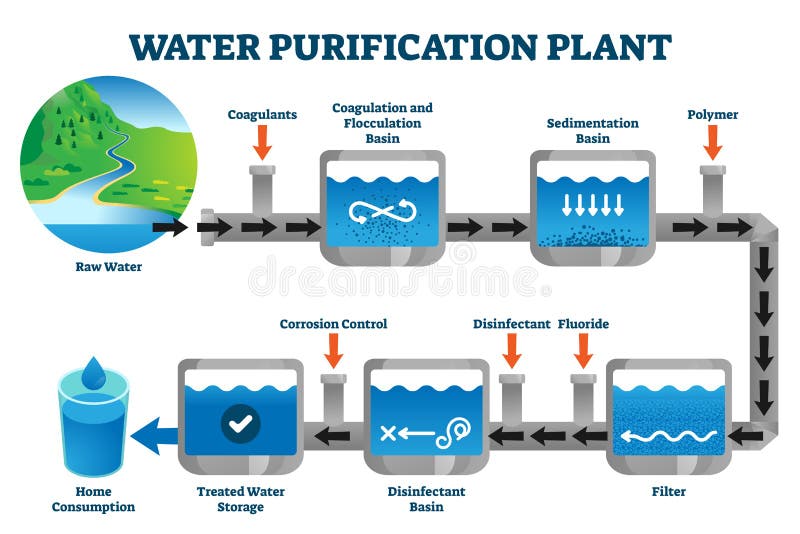Some Known Details About Residential Water Treatment System
Table of ContentsAbout Residential Water Treatment SystemRumored Buzz on Residential Water Treatment SystemIndicators on Residential Water Treatment System You Need To KnowResidential Water Treatment System Fundamentals Explained
5)5. 1 The requirement for massive water treatment, Water therapy is the process of removing all those substances, whether organic, chemical or physical, that are potentially damaging in supply of water for human and residential use. This treatment aids to create water that is risk-free, palatable, clear, colourless and odourless. Water also requires to be non-corrosive, suggesting it will not cause damages to pipework.This creates a need for big quantities of safe water to be provided dependably and continually, and also this demand is expanding. As city populations boost, there is a requirement to find brand-new sources to fulfill the expanding demand. If groundwater is offered this can often be used with very little therapy but any kind of surface water resource will certainly need to be treated to make it risk-free.
6 describes exactly how this calculation is made yet initially you will look at the primary phases in the water therapy procedure. 2) in large water therapy for metropolitan municipal water supply (Abayneh, 2004).

The Facts About Residential Water Treatment System Uncovered
Right here the water is delicately stirred by paddles in a flocculation container (Number 5. 5) and also the flocs enter into call with each other to develop bigger flocs. The flocculation container often has a variety of areas with reducing mixing rates as the water advancements through the basin (Number 5.
6(b)) for a number of hrs for sedimentation to happen. The product accumulated at the end of the tank is called sludge; this is gotten rid of for disposal. 5.2. 5 Filtration, Purification is the procedure where solids are separated from a fluid. In water therapy, the solids that are not separated out in the sedimentation storage tank are gotten rid of by passing the water through beds of sand as well as gravel.
7), with a flow rate of 48 cubic metres per square metre of filter surface per hr (this is created as 48 m3 m2 h1) are usually made use of. When the filters have lots of caught solids, they are backwashed. In this procedure, tidy water and air are pumped in reverse up the filter to remove the caught contaminations, and also the water bring the dirt (referred to as backwash) is pumped right into the sewerage system, if there is one.
5.2. 6 Chlorination, After sedimentation, the water is disinfected to eliminate any type of staying pathogenic micro-organisms. One of the most generally utilized anti-bacterial (the chemical used for sanitation) is chlorine, in the type of a fluid (such as sodium hypochlorite, Na, OCl) or a gas. It is relatively economical, and also easy to make use of.
Residential Water Treatment System for Dummies
The amount of chlorine left hereafter is called recurring chlorine. This remains in the water completely with the circulation system, securing it from any micro-organisms that may enter it, until the water gets to the consumers. Globe Health And Wellness Organization Standards (THAT, 2003) suggest a maximum recurring chlorine of 5 mg l1 of water.

7 Extra therapy, Additional treatment might sometimes be needed for the advantage of the populace. One such instance is the fluoridation of water, where fluoride is included to water. It has been specified by the World Health Company that 'fluoridation of water supplies, where feasible, is one of the most effective public health measure for the avoidance of oral decay' (THAT, 2001).

Not known Details About Residential Water Treatment System
5 mg l1. What does excess fluoride in the water result in? As stated in Study Session 2, in kids it can create mottling of teeth as well as long term exposure can trigger skeletal fluorosis and also crippling. In such high-fluoride locations, removal or reduction of fluoride (labelled defluoridation) is vital. The most basic way of doing this is to mix the high-fluoride water with water that has no (or very little) fluoride to make sure that the last mixture is secure - residential water treatment system.
The two chemicals are added to and also quickly mixed with the fluoride-contaminated water as well as then the water is mixed carefully. 5.3 Administration of wastes from water treatment plants, From the water treatment process that you have actually just researched, make a listing of the different wastes that develop.
In the last it is included in the inbound sewer, where it can his explanation assist negotiation of solids. The backwash from the sand filter is discharged into the drain or returned to the river after settlement of solids. Packaging waste such as chemical drums can be gone back to the provider for reuse.
5.4 Sustainability as well as resilience in water therapy, In Research home Session 4 you check out regarding some aspects that can affect the sustainability of a water source. Minimizing dirt disintegration by growing trees as well as retaining plants can lower the amount of silt that accumulates in a tank as well as prolong its life. residential water treatment system.